Education resources
Morning Circle
Click on the links below for videos of Jessica doing Morning Circles. Each week (or so), she gathers us together for the 4-H and Earth Pledges, nature appreciations, and a reflection. It’s a great way to connect to camp traditions at Tanglewood and Blueberry Cove. We look forward to sharing a little more of our world with you.
Note: we started these morning circles in June 2020 via Facebook Live. In November 2021, we changed our delivery to allow for capturing the transcript of words shared. For earlier videos, visit Tanglewood’s Facebook page.
03/08/2022 (a few weeks late) ?
Scroll down to find nature poems, quotations, jokes, templates for nature journaling activities, as well as mindfulness, STEM, group-building, and nature activities you could do by yourself or as a family. Or use the links below to jump directly to an activity (work in process!). Educational Resources
You can also check out Cooperative Extension 4-H Learn at Home Resources and follow us on Facebook to see live videos of these and other activities.
Seashore Scavenger Hunt
You can do a scavenger hunt almost anywhere! We did one today at the seashore. Where will you do a hunt? What will you look for?
Some examples of scavenger hunts we have used are the Rocky Shore Scavenger Hunt and the Beach Day Scavenger Hunt.

After you have collected your items, you can organize them by different categories such as color, size, species. What are some other characteristics you can use to organize your collection?
Check out our Facebook video of Jessica’s scavenger hunt and seashore museum!
Plant Shadows
The materials you need for this activity include:
- Pencil or writing utensil
- Paper and a surface to write/draw on
- A sunny outdoor space (or indoor space with a lamp or flashlight!)
Instructions:
- Go outdoors and spend some time looking at the plants that are around you and the shadows they create on the ground.

- Choose a spot with some interesting plant shadows where you can position your paper and writing surface so that the shadows fall on your paper.
- Trace the shadows onto the paper. Leave as is, or color your drawing with crayons, colored pencils, markers, or paint. Don’t forget to sign your artwork!
Reflective Questions:
- Why did you choose the plant that you did? What do you like most about it?
- Did you find tracing the shadows easier or more difficult than just trying to draw the plant directly?
- What did you notice about the plant you chose that you might not have noticed before?
Extensions of this activity
- Use this shadow drawing technique to create cards, bookmarks, wall art, wrapping paper, gift bags, and more to give as gifts to friends or family.
- After tracing the outline of the plant’s shadow, turn it into a scientific drawing by adding more details and descriptions. Include details about the date, time, location, and weather. Do this for as many plants as you want and add these to your nature journal.
- Using nature and/or man-made objects, move the objects into positions so that the shadows they cast create a scene. Trace the scene.
You can see Jessica demonstrate this activity in this Facebook video!
Mystery Box
This activity uses your sense of touch and wonder! The goal is not just to identify the items in your box but to challenge yourself to use your sense of touch to describe what you are experiencing. Keep in mind the statements of “I notice…”, “I wonder…,” and “it reminds me of…”
For this activity, you will need:
- A box or container that is big enough to stick your whole hand in but that you can not see through!
- Scissors to cut a hole in your container.
- Materials collected from nature.
Instructions:
- Have an adult help you cut a “door” in your container that is just large enough for someone to stick their hand through. (Optional: you can also decorate the outside of your box!)

- Collect your mystery objects. Make sure you have permission to collect things from whatever outdoor space you are exploring. Look for objects that have interesting textures, but cannot injure someone. Make sure the items are “dead, down and detached.”
- Challenge your family or friends! Place your objects in the mystery box and ask your friend to place their hands through the hole without peeking. Ask them to describe what they feel and try to guess the objects.
Reflective Questions:
- How did you decide what kinds of objects to include in your mystery box? Were there certain qualities that you were looking for?
- What kinds of observations did your friend make about the objects they were feeling? Were their observations different than the observations you made about the object?
- Were some objects easier for your friend to identify than others? Why do you think that is?
Extensions of this activity:
- Make it a game. Put 5 to 10 different objects in the box. Have your friend choose one without either of you looking. They should then list descriptive words one at a time until you are able to guess which object they chose. How many words did they need to list before you were able to guess the object?
- Switch roles. Have your friend find objects to put in the box for you to make observations about. Which role do you each like better? Why do you think that is?
- Try the same activity using objects found inside your house. Are indoor objects easier or more difficult to identify?
Watch Jessica fill her Mystery Box on Facebook!
Egg Carton Opposites
This activity is part scavenger hunt and part sensory exercise!
For this activity, you will need:
- A space to explore (i.e., backyard, a room in your house)
- Empty egg carton
- Optional: paper and pen to write down your observations and descriptions
Instructions:
- Explore your backyard or area for small items on the ground that will fit in the compartments of your egg carton. These items should be dead, down, and detached!
- Use your observation skills to describe the items you found. Come up with as many descriptive words as you can.

- What do these items remind you of?
- How did they feel?
- What do they smell like?
- Sort your items in the egg carton by opposite characteristics. For example, put a light-colored item across from a dark-colored item or a rough-textured item across form a smooth object.
- What are other opposites you can find in nature?
- Optional extended activities:
- show your carton to a friend or family member. Can they figure out the characteristics you used to sort the items?
- make a note of how you sorted your items, then empty your egg carton and give the items and the carton to a friend or family member to see how they would sort the items.
Reflective Questions:
- What senses did you use to make your observations?
- What were some new things you discovered about your items?
- How many pairs of items do you think you could find in your backyard? How many cartons would you need to sort them?
Watch our Facebook video to follow Jessica on her scavenger hunt to find items for her egg carton.
Invent an insect
For this activity, you will need:
- Your imagination
- Pencil and paper
Instructions:
- Imagine: if you were to design an insect, what would it look like? How long would its legs be? What kind of mouthparts would it have? If it had wings, what shape and color would they be? What about its antennae?

- Draw your insect. Label the parts that make it an insect: head, thorax, abdomen, six legs, two antennae, exoskeleton, and wings if it has them.
- Name your insect; is your name based on its appearance, behavior, or some other characteristic?
- Write or draw more about how your insect lives. In what type of habitat would your insect live? What would it eat? How would it avoid predators?
Reflective Questions:
- How do the different parts of your insect help it survive in its habitat?
- How might your insect help humans or other animals? How might your insect hurt humans or other animals?
- How is your insect similar to the insects in your backyard? How is it different?
Extensions of this activity:
- Build your insect! Use craft materials or materials from nature to build a 3D model of your insect.
- Draw real insects. Collect and observe insects from your backyard. Draw and label their body parts. Return them where you found them when you’re done.
Follow Jessica on a hunt for insects on our Facebook video.
Plant Pressing Activity
For this activity, you will need:
- an outside space
- several sheets of newspaper
- heavy books
Some optional items you may want include some pieces of cardboard, clear packing tape or contact paper, card stock or thick paper, or a nature journal.
Instructions:
- Collect some plants! Make sure to collect them from your own yard or from somewhere that you have permission to collect from.
- Arrange your plants or plant parts on half of several sheets of newspaper and fold the other half of the sheets on top.
- Place your plant-containing newspaper bundle on top of a book or other flat, solid surface. If you have lots of plants, you can make multiple newspaper bundles and layer them on top of each other with a piece of cardboard between each bundle.
- Place a heavy book on top of your layers. Add several more heavy books or another kind of weight on top.
- Wait. Depending on how large the plants are, it may take about a week for them to dry. You can check on them periodically and change the newspaper if it becomes wet.
- Enjoy your pressed plants. Check out the extensions below for some ideas on what you can do with them.
Click the link to watch our Facebook video demonstrating this activity.
Reflective Questions:
- How did you decide which plants to collect and press? How did you decide which parts of the plant to press?
- How do you think your plant will change as it dries?
- How do you think a scientist might use pressed plants to study different species?
Extensions of this activity:
- Create art with your pressed plants. You can make bookmarks, greeting cards, wall art, or window art. Keep some for yourself and give some as gifts.
- Add your pressed plants to your nature journal. Use ID guides to identify the plants you collect and label the species and all of the plant parts in your journal.
Nature joke of the day
Q. Why did the gardener plant light bulbs?
A. They wanted to grow a power plant!
A Love Letter to Place
All you need for this activity is some paper and a writing utensil but you may use other items to add color or decoration to your letter.
During this time of the pandemic, you may be feeling isolated and missing places that you have enjoyed visiting in the past. Think of a place that you miss and what you love and miss about it. Then write a love letter to that place starting with “Dear [insert the name of your place here], This is a love letter…” and go on to write what you love about this place.
To hear a love letter written by Jessica Decke and some former campers to Tanglewood, check out our July 8 Facebook video post!
Miss Bethany shared this activity with us that she learned from The Isolation Journals.
Nature joke of the day
Q. What did one volcano say to the other?
A. I lava you!
Picture Frame Activity
You will need an outdoor space and a “frame” cut out of paper or cardboard.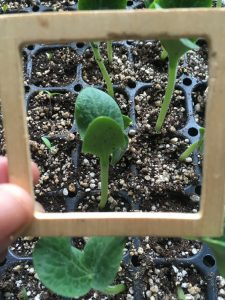
Take your frame outside and find something that you would like to frame and take a “picture” of. Contain your observation in the frame by standing still, and spend some time reflecting on what about that observation drew your attention– was it the color, the shape, how it cast shadows on the forest floor?
Reflective Questions:
- Why do different people notice different things/find different things beautiful?
- How are images with and without people in them different?
- What is something you would like to take a picture of up close?
Extensions of this activity:
- Make cut-out frames of multiple sizes and shapes; how does this variation affect your perspective?
- Photograph the contents of your picture frame and create a digital or printed album of your observations. Return to the same spot a few weeks or even months later; how has your picture changed?
- Frame observations from different perspectives– up close, far away, at a medium distance. How does this affect which details you notice?
Check out our Facebook video for a demonstration of this activity.
Nature joke of the day
Q. Which fish is the most famous at the beach?
A. The starfish!
June 24, 2020
Transpiration Bag experiment
This experiment will show transpiration in action. Transpiration is one of the steps of the water cycle we discussed on June 3.
You will need these supplies:
- Clear plastic bag
- String or twist tie
- Tree or plant
To start, find a leaf or bunch of needles on a tree. Place the plastic bag over the leaf or needles and tie it closed with the string or twist
tie. Make sure no insects are trapped inside the bag. The seal should be as tight as possible.
Leave the bag on the tree for a few hours or overnight. Return and remove the bag to observe what happened inside the bag.
You can try variations of this experiment by trying different species of trees and plants, leave the bag on for varying lengths of time and in shady and sunny locations.
How does changing some variables (sun vs shade, species of tree, etc.) affect changes inside the bag?
Reflective questions:
- What do you think you will observe happening in your
transpiration bag? - How do plants participate in moving water around on Earth?
- How is transpiration (tree breathing!) similar to and different from
human breathing?
Check out our Facebook video for a demonstration of this activity.
Nature joke of the day
Q. What did the flower say after it told a joke?
A. I was pollen your leg!
Make your own Biome!
A Biome is a large naturally occurring community of flora and fauna occupying a major habitat, e.g. forest or tundra.
To make your own miniature Biome, you will need:
- Plastic container with a lid
- Trowel or small shovel
- Water
- Sunny location, like a windowsill
- Place outside to dig small plants and collect other materials
Bring your plastic container and lid to an area outside where there are many tiny plants growing, like a forest. Gently dig up
some small plants, making sure there are no small insects or worms in your sample. Dig deeply enough to remove roots.
Place your plant and soil sample in your plastic container. Remember that you will be replacing the lid on your container, so
make sure the plants are not taller than the top edges of the container.
The sample in your container should be a miniature version of the larger surrounding habitat. Your sample might include fungi, moss, and rotting wood or bark, as well. Lightly sprinkle the sample with water and cover the top with the lid. Place in a sunny location, and watch your plants grow! You should not need to water your biome.
Check out our Facebook video for a demonstration of this activity.
Nature joke of the day
Q. Why A’s like flowers?
A. Because bee’s come after them!
Meet a Tree!

Nature joke of the day
Q. Why is the mushroom always invited to parties?
A. Because he’s a fungi!
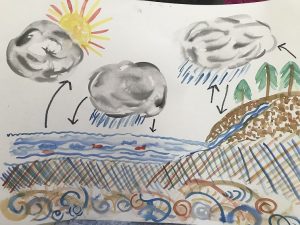


Nature joke of the day
Q. Why was the cucumber mad?
A. Because it was in a pickle!
May 29, 2020

What an intricate mixture of rock-dwelling, soil-loving, coniferous-needle material!
This is one of our favorite nature quotations by Ralph Waldo Emerson:
Adopt the pace of nature: her secret is patience.
- Growing anything in a garden, windowsill pot, or other inventive space requires patience! Here are some tips for growing backyard strawberries from kidsgardening.org
Nature joke of the day
Q. How do you properly identify a dogwood tree?
A. By its bark!

Look at the scale in this photograph (taken from the Tanglewood archives). Saw-whet owls are tiny!
- Owls are interesting! Here is what Audubon has to say about the Northern Saw-whet Owl, a species found in the Tanglewood forest. They nest in holes made by woodpeckers, like the ones pictured in our May 26th post.
- The Cornell Lab has several recordings of what the Northern Saw-whet Owl sounds like.
- Owl ears is one of our favorite games to play. Check out our lesson plan, and try it yourself!
- Also, check out this diagram of all the types of bones you might find in an owl pellet.
Nature joke of the day
Q. What do you say when the beach asks you to walk on it?
A. Shore

We always wondered if woodpeckers came back to the same tree year after year…
What do you notice about how the tree responds to the layers of its bark being excavated?
- Did you know that a woodpecker has several adaptations that hold its brain in place while it uses its beak to peck into trees? Read about this and more on kiddle’s woodpecker information page.
- This guide from allaboutbirds.org will help you identify exactly which species of woodpecker you are seeing and hearing.
If only, if only,” the woodpecker sighs, “The bark on the tree was as soft as the skies.” While the wolf waits below, hungry and lonely, Crying to the moo-oo-oon, “If only, If only.
–Louis Sachar, author of Holes
Nature joke of the day
Q. Where do rocks like to sleep?
A. In the bedrock
May 20, 2020


Spring is a time of change and growth for all living things. Amphibians like the wood frog (which can live in the arctic circle!) are great markers of this change. Imagine going from living in a blob of jelly-like goo to living underneath leaves in the forest!
How have you changed and grown this year?
- Here is what the National Wildlife Federation has to say about wood frogs
Nature joke of the day
Q. What runs but never gets out of breath?
Many of our pond creatures have different life cycles. The dragonfly and the caddisfly are two examples.


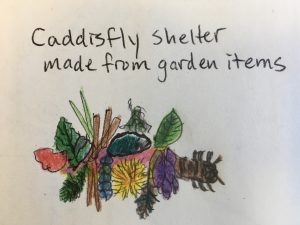
We challenge you to make or draw your own caddisfly shelters! Here is our lesson plan: Create-a-caddisfly shelter
- Kiddle on caddisflies
Nature joke of the day
Q. What do loggers eat in the forest?
A. Mac and trees!
May 18, 2020

We did some wondering about this picture and decided that it is indeed two dandelions stuck together! How and why does this happen? Is this type of growth rare or common?
Nature joke of the day
Q. What does seaweed say when it’s stuck at the bottom of the sea?
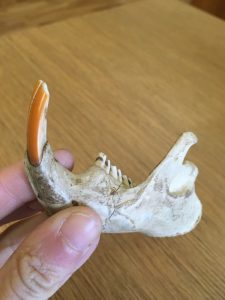
What do you observe about this skull that might give you a clue about what beavers eat?
Try this!
Build your own beaver dam
Gather materials you think might make an effective beaver dam, like sticks, mud, and bark. Build your dam in a nearby creek or stream, or use a plastic dish container to build one inside. Observe whether water flows from one side of your dam to the other. If you are building in a dish tub, pour water on one side and tilt it to test it! Take time to evaluate your dam and re-make it! You might do some research about how beavers make their dams or visit one near you to gather information.
Why do you think beavers build dams?
What is challenging about building a dam?
We built a beaver dam in a dish tray…it was not as effective as we expected!

- Here is what kiddle and National Geographic have to say about beavers
- Also, here is some beaver information and activities from the North Carolina Cooperative Extension.
Nature joke of the day
Q. What is a tree’s least favorite month?
A. Sep-timber
Evidence of beavers near Pitcher Pond!
We like to combine art and science projects. Check out this creative activity!
Create-a-creature
Materials Needed:
- Your imagination
- Materials gathered from nature
- Space to build
Instructions:
- Imagine: if you could build any imaginary creature to live in any habitat, what would your creature look and feel like? How would it move, hunt for or find food, and defend itself from predators? Does it use camouflage, have sharp teeth, or prickly skin?
- Gather materials from nature to create your creature. You can always gather more as you build, if necessary.
- Name your creature; is your name based on its appearance, behavior, or some other characteristic?
- Invite others to meet your creature – be sure to remember if there are any behaviors you need to warn others about, like a creature that has sharp spines or spits poison!
Reflective Questions:
- How might your creature react if it were moved to a different habitat?
- Why do animals sometimes act aggressively, or seem shy or curious around each other?
- What are some characteristics we share with other animals?
Extensions of this activity:
- Create a creature from indoor objects. Imagine: what is its favorite part of the house; what does it eat; and how does it get along with your pets, if you have any?
- Create a plant or a fungus or a combination of any of the kingdoms.
- Draw or photograph the important details of your creature– what does someone need to notice to be able to identify this creature in the wild?
Sample creature!

Nature joke of the day
Q.What did the beaver say to the tree?
A. It’s been nice gnawing you!
May 12, 2020
We love to practice our communication skills at Tanglewood! Try drawing a picture and describing it to someone else who can’t see it. Allow them time to try to make an exact replica (copy) of your picture. Notice which details in their picture match yours.

- What could be a reason for differences in the pictures?
- What feedback would you give the person describing their picture…to the person replicating the picture?
- What can you both learn from the first round that will help someone best describe their picture to you?!
Nature joke of the day
Q. What did the beach say to the surfer?
A. Nothing, it just waved
May 11, 2020

We tried our own decomposition line-up, which involved selecting objects from nature that were already detached from their sources (except for the dandelion)! We lined them up in order from most to least decomposed. We then noticed if there were any other patterns among the objects. For instance, we observed that some objects had stems and some did not.
- Kiddle on decomposition
- Michigan State University Extension’s ideas about how to make a decomposition hike entertaining!
Nature joke of the day
Q. What do you call the seagulls that live by the bay?


Can you spot the insect that is eating the starches (food!) found in this potato? These are long overdue for planting; we’ll put them in the ground this week!
Potatoes are an important crop in Maine, especially in northern Maine. Did you know that many communities give students “recess” from school during the fall harvest season so that they can participate in the potato harvest?
- Facts about potatoes and an insect that eats them from kiddle
- A bit of potato history from maineanencyclopedia.com
- Check out our FacebookLive segment today at noon; we are learning more about potatoes and setting up a potato-growing experiment we found on sciencing.com!
Nature joke of the day
Q. Where does seaweed look for a job?
A. In the kelp-wanted section
May 6, 2020

- We did a series of zoom drawings looking at an object from far away and then closer…and closer. More science and art activities like this are detailed in the latest edition of our Tanglewood journal.
- Here is a fun matching activity you can do outside or inside. See the instructions for Shape matching!
Nature joke of the day
Q. What did the little tree say to the big tree?


The name dandelion comes from words that mean, “lion’s tooth;” can you guess why?
Some people dry and grind dandelion roots to make a non-caffeinated coffee. Dandelions provide pollen and nectar for bees early in the spring. We welcome these “weeds” into our green spaces!
- Dandelion facts and history from kiddle
- What can you do with dandelions?!

This is one thing you can do with dandelions. All the colors in this picture come from a dandelion-paintbrush!
“The First Dandelion,” a poem by Walt Whitman from his collection, Leaves of Grass
Simple and fresh and fair from winter’s close emerging,
As if no artifice of fashion, business, politics, had ever been,
Forth from its sunny nook of shelter’d grass — innocent, golden, calm as the dawn,
The spring’s first dandelion shows its trustful face.
Nature joke of the day
Q. How do you cut a wave in half?
A. Use a sea saw

“Neat Nature” brings us a forest in miniature!
Here are some links to museums around the world with interesting virtual exhibits and family activities.
- American Museum of Natural History
- The Field Museum
- Insect Museum in Costa Rica
- Natural History Museum in London
Watch our FacebookLive video on building a forest museum around where you live– always posted around noon!
We like making museums because the process encourages us to notice patterns, organize and categorize objects in interesting and different ways, and be creative in our design process. Museums also create a sense of audience as we show others what we have designed.
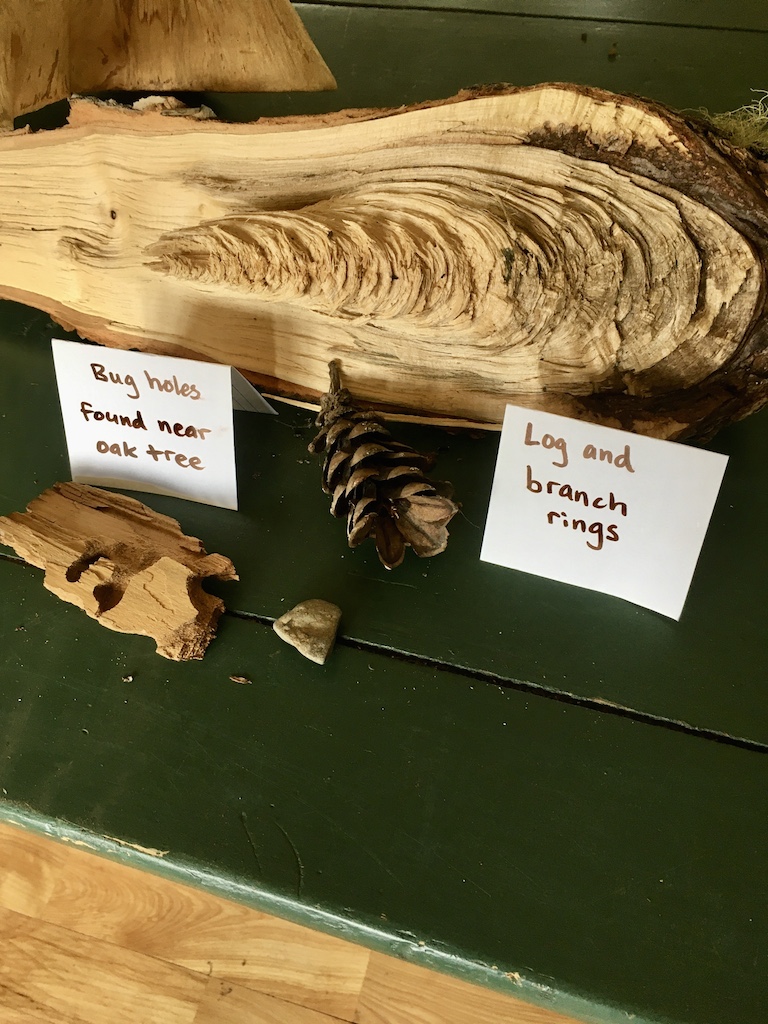
Here is an example of a small forest museum created indoors from the Tanglewood “interesting forest items” archive.
Nature joke of the day
Q. Why is grass so dangerous?
A. Because it’s full of blades!

Nature is neat; snow-covered tulips are sweet!
Try this
Writing a note of gratitude
- List something special someone did for you or something they did that made you happy or joyful.
- List the character trait that they demonstrated.
- Offer words of gratitude or encouragement.
- Hide the notes you write around your living space and invite those who live with you to find them. It can feel as good to write notes as it does to receive them!
Sample note of gratitude

Check out our Facebook post on writing notes of gratitude. Here is a list of character trait words you can use to express gratitude from the E-reading worksheets website.
Nature joke of the day
Q. What kind of shorts do clouds wear?
A. Thunderwear

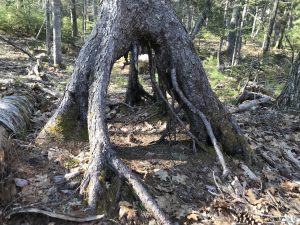
These are two sure signs of water flow within the forest. How would you describe what you notice in these two pictures to someone else?
- We know that trees can “walk,” but did you know that trees can also “talk” to each other? The BBC has some interesting insights on how trees “talk” to each other.
- Here are some tree-mendous outdoor family activities from Project Learning Tree.
Try this!
You could make a tree-ring life story map. Trace a plate or other circular object on a piece of paper. Draw smaller circles inside. You could do one circle for each year of your life or fewer if one for each year seems like too many! Label each line with a significant year and event in your life, starting in the center with the earlier years. You could draw pictures within the rings to remind you of your life events.

This is the tree ring life story of someone from Tanglewood– guess who?!
Nature joke of the day
Q. What did the trees wear to the pool party?
A. Swimming trunks


The water in saltwater swamps helps hold soil and sand in place, just as tree roots do in the forest. These are pictures of a freshwater swamp, which acts both a sponge and a filter, soaking up and purifying contaminated water that may flow into it.
What do you notice about the tree in the middle of this swamp? What do the leaves in the second picture remind you of?
- Here is what National Geographic has to say about swamps.
- Swamps are nature’s nutrient recyclers– check out our Facebook page for a video posted from today about another way to recycle nutrients.
- This is a link to our Tanglewood journal (PDF), some printable pages you can take with you on your outdoor adventures! We will post more pages in the middle and end of May.
Nature joke of the day
Q. What happens when you go to the beach and throw your hat in the water?
A. It gets wet!

I wonder…why do some trees keep their leaves in the winter?
Roots are important because they anchor plants, like beech trees, in the soil. This prevents trees from blowing down in high winds.

Here is an example of how roots contain soil to support plants.
- Kiddle on beech trees and tree roots
This is an excerpt from the poem, “Good Timber,” by Douglas Malloch:
Good timber does not grow with ease:
The stronger wind, the stronger trees;
The further sky, the greater length;
The more the storm, the more the strength.
Nature joke of the day
Q.What did the tree do when the bank closed?
A. It started its own branch!
Happy Earth Day!
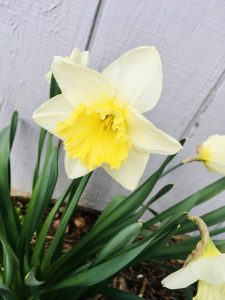
Our “Neat Nature” photo reminds us that spring pollinators will be buzzing about soon. Daffodils are bulbs, which means they store energy, as well as their stem, leaves, roots, and flowers over the winter underground in one compact bundle!
Try this:
Find a clove of garlic that has started to sprout indoors or dig up a daffodil or tulip bulb outside, if there are plenty around. Dig into it with your fingers, or have an adult help you cut it open with a knife. What do you notice, wonder…does it remind you of…? Can you see next year’s plant parts forming?
- Here is what the National Geographic Kids website has to say about Earth Day.
- The University of Illinois Extension has much to say about bulbs.
Nature joke of the day
Q. What has no fingers, but many rings?
A. A tree

Look what sprouted on the Tanglewood windowsill after only six days!
These seeds were planted in seed-starting soil, which is low in minerals but very fine and crumbly to allow roots to grow and expand and to let water flow freely, so the young roots do not get too much water. Later on, these seedlings will be replanted in our garden beds, which do contain minerals plants need to grow. Moisture and warm soil were the two main things these seeds needed to germinate or sprout.
What else besides minerals do plants need to grow?
- Information about soil from Kiddle, a source of encyclopedia facts for kids.
Did you know that depending on where you live, soil forms in predictable layers?
- Layers of soil from Eco Kids Corner.
Watch our video exploring soil on Facebook.
“The soil is the great connector of lives, the source and destination of all. It is the healer and restorer and resurrector, by which disease passes into health, age into youth, death into life. Without proper care for it, we can have no community because without proper care for it we can have no life.” ― The Unsettling of America: Culture and Agriculture
Nature joke of the day
Q: Why is a fish easy to weigh?
A: Because it has its own scales!



How would you interpret each of these “Neat Nature” photos?
Check out our Facebook page for some awesome footage of the Ducktrap River watershed. As usual, our video segments are posted or hosted live at noon each day.
- Here are some resources for kids from the National Oceanic and Atmospheric Administration
You can build your own watershed at home by creating landforms with a square of aluminum foil. Take the foil outside, pour water on top of it, and watch where it flows. You could also build a larger watershed with natural materials outside, cover it with a tarp, and pour water on the top.
What do you think would happen if you put soil on some of the highest points of your watershed?
How about if a tiny car with an oil leak drove around the landforms?
How does the watershed you created compare to how water flows around where you live?


Here is a watershed that the Tanglewood staff built, shown before and after placement of the tarp. We used the watering can to pour water on the tarp. What types of landforms do you notice? Where do you predict the water will gather?
“All drains lead to the ocean.” –Gill, Finding Nemo
Nature joke of the day
Q: What did the judge say when the skunk walked in the courtroom?
A: Odor in the court!
April 16, 2020

There are many reasons why trees grow like this– one is a fungus that infects the tree– can you think of any others?
- Here is some information on unusual plant growths from the Missouri Botanical Garden.
- Our FacebookLive post today explained the “Mystery bag” activity.
Mystery bag
Hide some items from nature in a bag. Give the bag to someone else and have them use their sense of touch to feel what is inside the bag without looking. They guess which items they are seeking, and search for matches for the items. Open the bag, peek inside, and see if the items match!

Speaking of mysteries…you never know what you might find when you go to open the mailbox! We are glad that predators like spiders are emerging to control insect populations in our gardens.
In the depth of winter, I finally learned that within me there lay an invincible summer. –Albert Camus
Nature joke of the day
Q: What did the farmer call the cow that had no milk?
A: An udder failure.

Look what we found making trails on Tanglewood Road!
Walking on trails can be interesting, invigorating, and inspiring. We wondered about the work that goes into building trails and the history behind the National Parks.
- Here is our Un-nature trail lesson plan demonstrated on our Facebook page. This is a fun type of trail that you can build either outside (using items that are NOT usually found in nature) or inside (using items that ARE usually found in nature!)
- This is some history about trail building published by the Forest History Society.
- National Parks were and are important and sacred places for indigenous peoples who lived there before the National Parks were created. This is an article from Roadtrippers magazine about the impact dispossession (taking land and resources away) and resettlement (moving away, often not by choice) had and continues to have on indigenous peoples.
What is the most unexpected thing you have ever found on a trail? For one Tanglewood staff member, it was the motivation to keep running on very sore legs– can you tell by her smile?

Nature joke of the day:
Q: What do you get when you cross a snake and a pie?
A: A pie-thon!

What better time than spring to become fascinated by leaf and flower buds?
- A family activity about leaf buds from Project Learning Tree
- An encyclopedic gathering of information on leaves from Kiddle
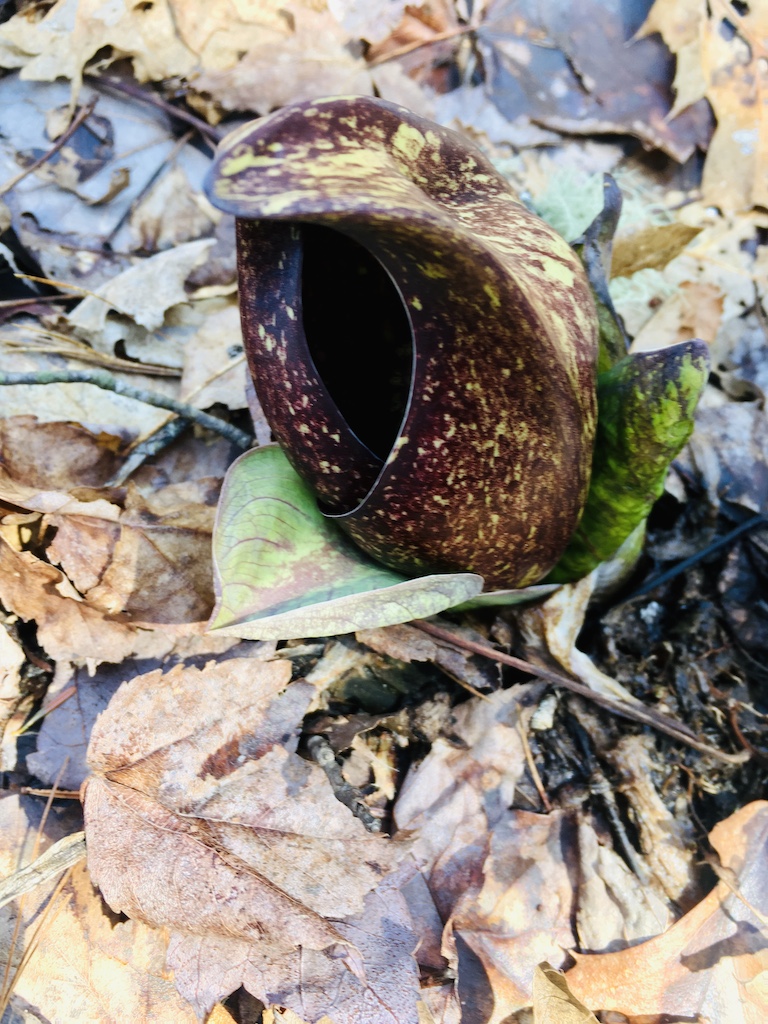
We found this curious bud in a swampy area on the Tanglewood trails. What could it be protecting?
- Information about skunk cabbage from Wapello County Conservation
“Piglet noticed that even though he had a Very Small Heart, it could hold a rather large amount of Gratitude.” — A.A. Milne, Winnie-the-Pooh
Nature joke of the day:
Q: Why are teddy bears never hungry?
A: They are always stuffed!

Our “Neat Nature” photo gives clues about how this cherry tree was structured on the inside– what a rare view!
Fun fact: Several Tanglewood staff members did not go to school to study ecology! We have other interests and talents.
Here is a reflective poetry writing activity that was inspired by one staff member’s brief career as a writer.
- George Ella Lyon’s website, with her original version and many written and video versions of the “I am from” poem
- One template for an “I am from” poem written by Levi Romero
- An “I am from” activity guide from the University of Minnesota; this explains the personal and educational values of writing this reflection
- Check out our Facebook post from today, where a Tanglewood staff member reads her “I am from” poem out loud.
Nature joke of the day:
Q: Why do gorillas have big nostrils?
A: Because they have big fingers!
April 9 and 10, 2020

Our “Neat Nature” picture is large enough to notice the details of a special three-leafed plant growing near the moss. Can you spot it?
As more spring plants emerge, it can be fun to use field guides to identify them and learn what their role is in the forest ecosystem.
- Here is some information on the three-leafed plant above.
We identified this plant using a dichotomous key. A dichotomous key is typically used to classify and identify living things by providing choices (usually two at a time) that divide living things into smaller and smaller groups. For instance, does this plant have leaves or needles that stay on year-round or do they fall off in autumn?
- This is a virtual dichotomous key from the Environmental Education for Kids website that you can use to identify evergreen (leaves or needles that stay on year-round) and deciduous trees (leaves or needles that fall off in autumn). It might be easier to identify evergreens at this time of year! Take pictures or find samples of leaves on the ground to bring back inside to identify.
For fun, we classified some kitchen items using our own made-up dichotomous key! We made this key by noticing similarities and differences among the items. Then, we divided them into groups based on those similarities and differences. There were many possibilities for creativity during this activity because people noticed and knew different things about each item!
This was actually all one key, with the first two categories being “metal” and “wood,” but the key was too big to fit all in one picture!

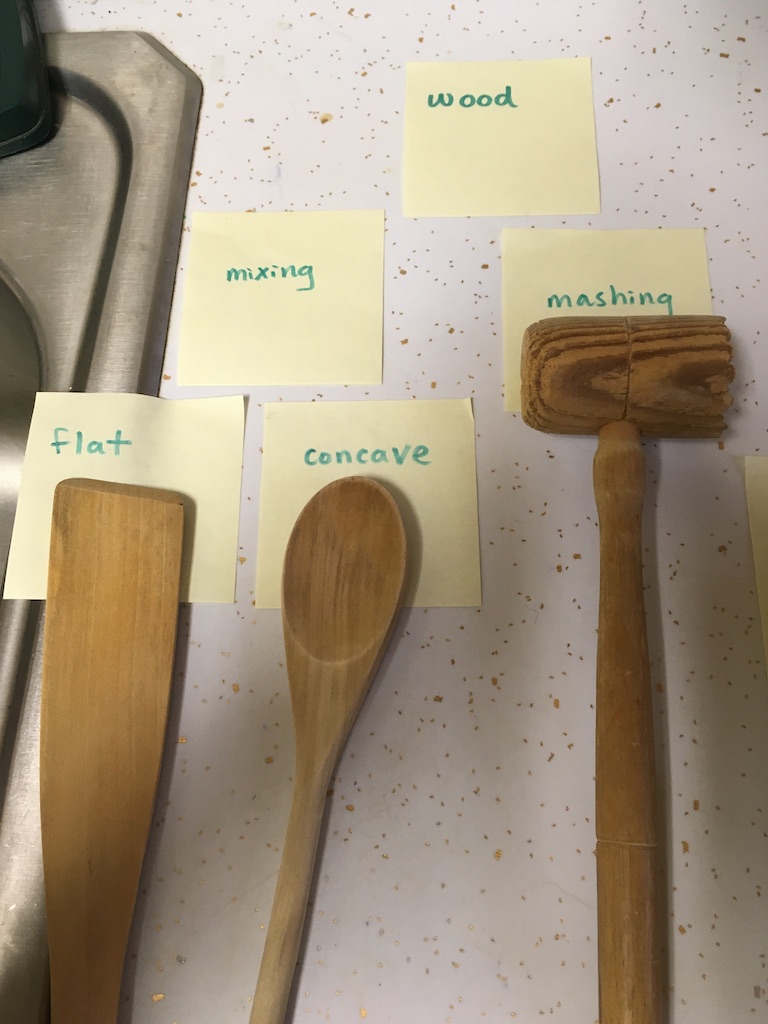
You can make your own dichotomous key at home using any found items or, you could use the provided tree key to identify the trees in your area.
Check out our Facebook page for a video of Tanglewood staff making a dichotomous key.
Nature joke of the day:
Q: Why didn’t the boy believe the tiger?
A: He thought it was a lion!

We were inspired by these patterns in tree bark to research other patterns in nature.
- This is what The Franklin Institute in Philadelphia has to say about math patterns in nature.
- Turn a family nature walk into pattern-finding fun! Kids Discover Online has some ideas.
- We encourage you to go outside and observe patterns around you. How do patterns change over the course of the seasons? Which patterns do you notice right away, and which patterns do you have to spend more time to find?
- We found a link describing one family’s process for making mandalas (circular patterns) in nature.
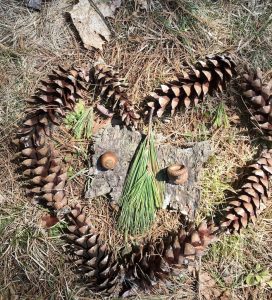
Here is a mandala we made at Tanglewood.
Nature joke of the day:
Q: What game did the cat like to play with the mouse?
A: Catch!


These two “Neat Nature” images were not sought after; rather, they were found accidentally.
- Here is a resource for those who like forest secret missions. These are the ones Tanglewood uses, but you could make your own indoor and outdoor versions based on what you have around you! Cut them out, and go explore! We demonstrated this activity on Facebook.
Stepping away from a warm woodstove, homemade blueberry pancakes, or a comfortable couch can be tough, so here are some motivational words from one of my favorite observers:
‘Come, Watson, come!’ he cried. ‘The game is afoot. Not a word! Into your clothes and come!’
Sherlock Holmes
Nature joke of the day:
Q: Why can’t leopards hide?
A: Because they are always spotted!

This “Neat Nature” picture was taken near some amphibian habitat. Barred owls and other birds of prey often wait in its branches…frogs beware!
- National Geographic has a great description of amphibians and picture links to some specific ones to research. In Maine, curious observers will often see a mass migration of amphibians in the early spring, during a special window of time called Big Night.
- What is Big Night? In our own words, it’s when amphibians, like salamanders and frogs, move from their woodland overwintering habitats to the vernal (seasonal) pools and ponds where they mate and lay eggs. It happens when it is raining, when the temperature is above freezing, and when vernal pools and ponds have thawed.
- Here is what Maine Audubon has to say about Big Night!
- This is a diagram of the amphibian life cycle from a website called Our Homework Help.
- Check out our Facebook page for a unique way to use this diagram to discuss thoughts and feelings and to hear some sounds of local-to-Lincolnville, Maine amphibians!
Nature joke of the day:
Q. What runs but never gets out of breath?
A. A river!
April 2 and 3, 2020
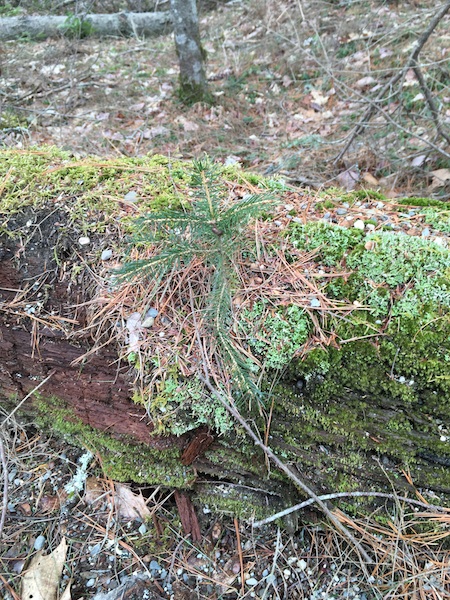
“Neat Nature!” Decomposition supports new life in the woods!
Here is an image of the Soul of Sole reflection demonstrated on our Facebook page.
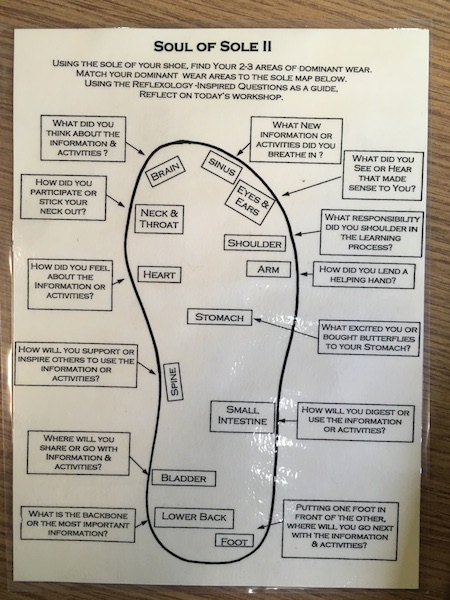
- Here are some tips on writing a haiku from Poetry4kids.com
Rainy day haiku
Deep puddle jumper
Gutters dripping, mud slipping
Dirty shoes, old news
Nature joke of the day:
Q: What happens when it rains cats and dogs?
A: You can step in a poodle!
April 1, 2020

Tanglewood and Blueberry Cove staff members are so creative! Our assistant director has a passion for all things marine and insects, so here’s what she made. Look below for another way to nurture a creative mindset…
Labyrinths
“You enter a maze to lose yourself and a labyrinth to find yourself.”
– The Labyrinth Builders website
- Many people think labyrinths are the same as all mazes, but they are actually a special type of maze that has a unique purpose!
- How to draw a labyrinth
- Check out our Facebook page around noon for a live demonstration of how to draw a labyrinth.
- Here is a link to an image of the labyrinth in Belfast, Maine. It’s in the park right above the boathouse.
Nature joke of the day:
Q: What is ‘out of bounds’?
A: An exhausted kangaroo!



Today I noticed evidence of animal activity. I was humbly reminded that you should never go tracking when you have someplace to be! One of these pictures is extra-tricky, because it is tilted sideways.
Here are some of our favorite tracking resources:
- 36 Most Common Animal Tracks (in North America)
- Canadian Wildlife Federation on tracking
- Tracking mysteries from the Garden Earth Naturalists
- Tracking card print out from Project Seasons
Nature joke of the day:
Q: What happened when the lion ate the comedian?
A: He felt funny!
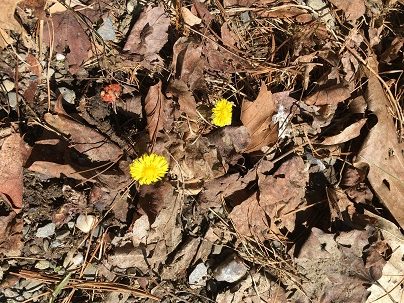
This is one of the first flowers that comes out each spring. What surprises have you all seen lately emerging from the remnants of fall and winter?
- Here are instructions for one of my favorite cold, rainy day activities.
Invention Convention
Students find materials outside or around the house to create an entirely new invention. This invention must be useful in some way and be able to be demonstrated. Each student (or group of students) will be responsible for creating and demonstrating how their invention works as well as advertising their invention to the large group. The advertisement could be a song, poem, dance or more traditional commercial. Others listen to each presentation and may be given the opportunity to ask clarifying questions/give feedback. Take some time to try out others’ inventions. Do they work as you expected?! What can you re-design to make them more effective?
- Invention Convention is actually a worldwide program. Check out what other participants around the country are doing here!

These are materials I found for my invention…



Here are my inventions! They are called… __________________________ (you may name them!) One is meant to support reminder notes so I can see them better, and the other is a marble race track!
Look on our Facebook page for a video demonstration of this activity.
Nature joke of the day:
Q: Why is a fish easy to weigh?
A: Because it has its own scales!

Certain sights and sounds attract my attention right away! Why do you think it would be useful for other animals to notice plants like this?
- Here is a link to the Cornell FeederWatch camera https://www.allaboutbirds.org/cams/cornell-lab-feederwatch/
- Backyard birding is fun, and you can help scientists study the habits of birds. Here is how you can contribute meaningful data through Project FeederWatch
- Making sound maps is a great way to spend some peaceful time outside as a family. This link is from Families in Nature.
Here is a sound map made at Tanglewood.

Nature joke of the day:
Q: Why did the snake cross the road?
A: To get to the other ssssssside!
March 26, 2020
This “Neat Nature” photo was taken in Montana. See if you can identify at least three mammals that walked in this mud…you might have to do some research since several are not native to Maine!

- In the spirit of virtual travel, here is a link to the Georgia Aquarium Ocean Voyager Cam.
Nature joke of the day:
Q. What do you call a sleeping bull?
A. A bulldozer!
Today our “Neat Nature” sighting reminded me of how much I like catching raindrops on my tongue! What does it remind you of?

This is something I like to eat that grows on the forest floor at Tanglewood. It tastes like my toothpaste! A word for the wise– never try any wild edible unless you are with an expert who knows that it is safe to eat!
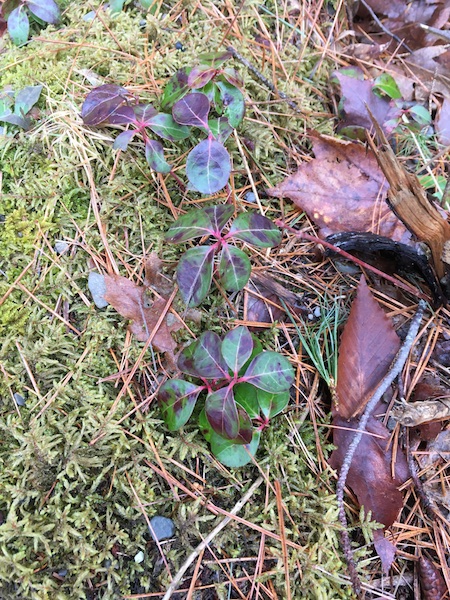
Here are some sensory activities to try at home with a theme of taste — yum!
- Taste bud mapping science experiment for older students
- Animal taste game for younger students
One way we like to frame our garden taste tests at Tanglewood (adapted from FoodCorps) is by using the phrasing… I tried it, I liked it, or I LOVED it! Have students vote on one of those categories after tasting.
Nature joke of the day:
Q. What do you get when you cross a cat with a lemon tree?
A. A sour puss!
Finally… here is a poem about taste. It is a Tanglewood original. Try coming up with a list of taste words, and write your own.
Tanglewood’s tastes
Tanglewood’s tastes are wild and woody…
Purpling wintergreen, mellow and minty; pyramided firewood scorched and seasoned; logs fallen forlornly, robust and rotten; a sample of the Ducktrap, bitter and briny…
Lemon clover’s aroma tainted and tart; a boon for the tastebuds, bliss for the heart!
Our “Neat Nature” sighting is green, slimy, and mysterious. If you find some outside, it is safe to touch. How would you describe its texture?

This collecting activity, called Twelve textures can be done inside or outside. Using an old egg carton or any other collecting container, try to find twelve objects with different textures. You might hide your findings from a family member and challenge them to close their eyes. Place one object at a time in their hand, and ask them to guess what it is. You might ask… is it prickly or tickly?


These are some twelve textures objects Tanglewood staff collected outside. Which ones do you think would be easier or more difficult to tell apart? Why?
- This is another tactile activity for budding mudologists from the MassAudubon website.
- Tanglewood also has its own expert mudologist. Catch some footage of her adventures on Facebook.
Nature joke of the day:
Q. How can you tell the ocean is friendly?
A. It waves

I spy games, like “Hidden in Plain Sight,” can be played indoors or outdoors. Take a close look at these items…
…and see if you can spot them here, hidden within this household scene!
- Check out our “Neat Nature” posting and video clip on Facebook to see an outdoor variation of this game.
- Reflections and beautiful images from Maine Master Naturalist Leigh Hayes: wondermyway
- The Harpswell Heritage Land Trust is also posting activities to try each day.
Nature joke of the day:
Q. What do you call bears with no ears?
A. B!

Here is our “Neat Nature” picture of the day. This time of year, water is present in many forms! What patterns do you notice in this ground ice?
- Weather-related activities to try at home
- How to make a rain gauge
- Water cycle song
- Check out our Facebook page for a few short video clips demonstrating how to make a rain gauge.
Finally… what are some things these four images have in common? (There are many interesting answers!)




Nature joke of the day:
Q. Why do fish live in saltwater?
A. Because pepper makes them sneeze!


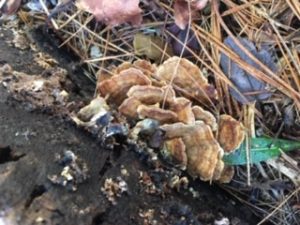
Can you find our (insect) “Neat Nature” sighting camouflaged in one of these pictures? Hint: it is a different view of the one we posted on Facebook! Check there periodically for short clips detailing our adventures at Tanglewood and in surrounding outdoor spaces!
An insect poem by Ginger Anderson
I like ladybugs, beetles, and bees,
Insects that never eat plants and trees.
Bees make us honey, and although they can sting,
They pollinate the flowers of everything!
The mantis looks fierce, dragonflies are neat,
Caddis and mayflies, the fish like to eat.
There are plenty of insects that annoy, sting, or bite,
But many are like butterflies: a natural delight!
- FBI song by the Banana Slug String Band
- Identify the insects you find!
- Fungus, Bacteria, Invertebrate (FBI) search activity
- FBI search activity example
Nature joke of the day:
Q: What creature is smarter than a talking parrot?
A: A spelling bee!

Here is our “Neat Nature” sighting of the day. We noticed that some cattails were fluffy and some were not. We wondered how many cattails were in the pond. The cattails reminded us of hot dogs or marshmallows on sticks. What did you observe today? What did you notice or wonder?
One important routine that includes making observations is a daily sit spot. Look below for sit spot resources, as well as templates for guiding daily nature observations.
- Check out this BEETLES website link that explains how to make observations using the phrases, I notice, I wonder, it reminds me of
- The Wilderness Awareness School has some insights on sit spots
- These are templates for daily nature journal entries Nature Walk Observation Notebook and Nature Study
- Sample Nature Study
- Sample Nature Walk Observation Notebook
- Simple observation guidelines
- Student work
Nature joke of the day:
Q: What is a cat’s favorite color?
A: Purrr-ple
As always, check out our Facebook page for more pictures!
March 16, 2020

This is our “Neat Nature” sighting of the day. We noticed this vine with berries– can you identify it? We encourage you to go outside or look out a window and make your own daily observations. We post ours on our Facebook page. You are welcome to comment on our sighting or post and share your own sightings there!
Nature joke of the day:
Q. Where do saplings go to learn?
A. Elementree school



